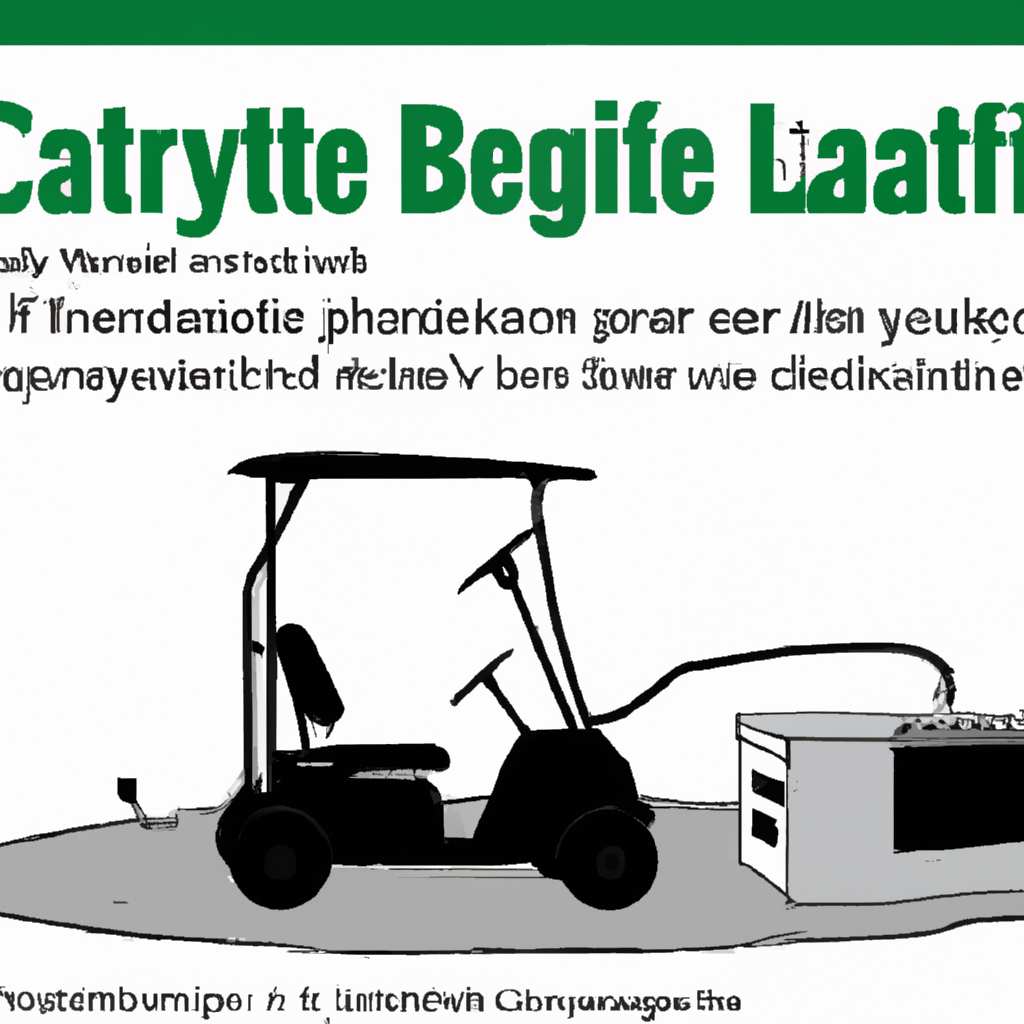We may earn money or products from the companies that may be mentioned in this post.
If you’re a golf enthusiast or someone who relies on a golf cart for transportation, you’ve probably wondered about the lifespan of golf cart batteries. After all, these batteries are the lifeline that keeps your cart running smoothly, and knowing how long they typically last can help you plan for future maintenance and replacements. In this article, we will explore the average lifespan of golf cart batteries, factors that can affect their longevity, and essential tips to maximize their performance. So, if you’re ready to get the most out of your golf cart batteries and ensure a smooth ride every time, let’s dive in!

Factors Affecting Golf Cart Battery Lifespan
When it comes to the lifespan of golf cart batteries, several factors can significantly influence how long they last. Understanding these factors and taking appropriate measures can help extend the battery lifespan, saving you time and money in the long run. In this comprehensive article, we will explore each factor in detail and provide useful tips and maintenance practices to maximize the longevity of your golf cart batteries.
Quality of the Battery
The quality of the battery itself plays a crucial role in determining its lifespan. Several aspects contribute to the quality of a battery, including the battery brand and manufacturer, construction and design, plate technology, and battery capacity and voltage.
Battery Brand and Manufacturer
Choosing a reputable battery brand and manufacturer is imperative to ensure the battery’s overall quality and performance. Well-established manufacturers with a history of producing reliable batteries are more likely to provide products with longer lifespans.
Construction and Design
The construction and design of the battery directly impact its durability and longevity. Batteries with sturdy build and robust materials are more likely to withstand the rigors of regular use and last longer.
Plate Technology
The type of plate technology used in the battery can affect its lifespan. Options such as flooded lead-acid batteries and newer technologies like gel or lithium-ion batteries may have different durability and lifespan characteristics.
Battery Capacity and Voltage
The battery capacity, measured in ampere-hours (Ah), and voltage are vital factors in determining the battery’s performance and lifespan. Higher capacity batteries with suitable voltage for your golf cart’s power requirements may last longer and provide better overall performance.
Usage and Maintenance
Proper usage and regular maintenance are essential for maximizing the lifespan of golf cart batteries. Factors such as the number of cycles, depth of discharge, cleaning and inspection practices, and regular watering or electrolyte level checking play key roles in prolonging battery life.
Number of Cycles
The number of cycles a battery goes through directly affects its lifespan. Each discharge and recharge cycle contributes to the gradual degradation of the battery. Therefore, minimizing the number of cycles, if possible, or using a battery with a higher cycle life rating can help extend its overall lifespan.
Depth of Discharge
The depth of discharge refers to how much energy is drained from the battery before recharging it. Shallow discharges, where the battery is not fully emptied before recharging, are generally better for battery health and longevity. Avoiding deep discharges maximizes the lifespan of the battery.
Proper Cleaning and Inspection
Regular cleaning and inspection are crucial for maintaining battery health. Remove any dirt, debris, or corrosion from the battery terminals and connections. Inspect the battery for signs of damage or wear, such as cracks or leaks, and address them promptly.
Regular Watering or Electrolyte Level Checking
For flooded lead-acid batteries, maintaining the proper water or electrolyte level is vital. Regularly check the levels and add distilled water as needed to ensure the plates are adequately submerged. Proper water levels promote efficient battery function and prevent damage from improper electrolyte concentration.

Charging and Discharging Patterns
How you charge and discharge your golf cart batteries can significantly impact their overall lifespan. Following proper charging practices, avoiding undercharging and overcharging, considering opportunity charging, and ensuring proper resting and storage are all important factors to consider.
Proper Charging Practices
To maintain battery health, it is crucial to follow the manufacturer’s recommended charging practices. Use a suitable charger that matches the battery’s voltage and capacity specifications. Overcharging or undercharging can lead to premature battery failure, so it is essential to charge the battery fully and avoid leaving it connected to the charger for extended periods unnecessarily.
Undercharging and Overcharging
Both undercharging and overcharging can negatively affect battery lifespan. Undercharging, where the battery is not fully charged, can lead to sulfation and reduced capacity over time. Overcharging, on the other hand, can cause excessive heat and stress on the battery, leading to accelerated degradation. Avoiding both extremes is essential for maximizing battery lifespan.
Opportunity Charging
Opportunity charging, which refers to short intermittent charging sessions between uses, can be beneficial in certain situations. It allows you to keep the battery at a reasonable state of charge, reducing the depth of discharge. However, be mindful of overcharging during opportunity charging, as it can still have negative effects on the battery.
Proper Resting and Storage
When not in use, proper resting and storage of the batteries are crucial. If you plan on storing the batteries for an extended period, ensure they are fully charged. It is also advisable to disconnect the battery from the golf cart to prevent any unintended power drain. Store the batteries in a cool, dry place away from extreme temperatures and sources of heat.
Environmental Conditions
Environmental conditions can significantly impact the lifespan of golf cart batteries. Factors such as temperature, humidity, altitude, and exposure to sun and rain all play a role in battery performance and longevity.
Temperature
Extreme temperatures, both hot and cold, can negatively affect battery performance and lifespan. High temperatures can accelerate battery degradation, while freezing temperatures can reduce battery capacity. Whenever possible, store and use the batteries within the manufacturer’s recommended temperature range for optimal performance and longevity.
Humidity
Excessive humidity can contribute to corrosion and the formation of battery-damaging condensation. While most golf carts are designed to withstand moderate levels of humidity, it is important to avoid exposing the batteries to excessively humid environments whenever possible.
Altitude
Operating golf carts at higher altitudes may impact battery performance. Due to lower oxygen levels in high-altitude environments, batteries may experience reduced performance and a potential decrease in overall lifespan. If you frequently use your golf cart in high-altitude areas, consider consulting the battery manufacturer for specific recommendations.
Exposure to Sun and Rain
Avoiding prolonged exposure to direct sunlight and rain is crucial for maintaining battery health. Sunlight can increase the temperature of the battery, potentially leading to accelerated degradation, while rain can introduce moisture and cause corrosion. Whenever possible, park your golf cart in a shaded and dry area to minimize exposure.
Signs of a Failing Golf Cart Battery
Understanding the signs of a failing golf cart battery is essential to address battery issues promptly and prevent more severe damage. Here are some common indicators that your battery may be near the end of its lifespan:
Reduced Run Time
If you notice a significant decrease in how long your golf cart can run on a single charge, it may indicate that the battery’s capacity has deteriorated. Reduced run time is often a clear sign that the battery is nearing the end of its lifespan.
Decreased Power Performance
A failing battery may not provide sufficient power to propel the golf cart as it did when it was new. If you observe sluggish acceleration or reduced top speed, it may indicate that the battery’s capacity has significantly decreased.
Battery Indicator Light
Many golf carts are equipped with battery indicator lights that monitor the battery’s state of charge. If you notice the indicator light consistently showing a low charge or flashing warning signs, it is important to investigate further as it may indicate a failing battery.
Battery Voltage
Measuring the battery voltage with a reliable voltmeter can provide insights into its health. If you consistently measure a significantly lower voltage than the battery’s rated voltage, it may indicate internal degradation and reduced battery capacity.
Battery Maintenance to Extend Lifespan
To prolong the lifespan of your golf cart batteries, regular maintenance is essential. Here are some battery maintenance practices that can help maximize their longevity:
Regular Cleaning
Clean your batteries regularly to remove dirt, debris, and corrosion from the terminals and connections. Use a mixture of baking soda and water, applying it with a brush and wiping it clean. Remember to wear protective gloves and goggles while handling battery cleaning solutions.
Proper Watering or Electrolyte Level Maintenance
If you have flooded lead-acid batteries, regularly check the water or electrolyte levels and add distilled water as needed. Maintain the electrolyte level between the manufacturer’s recommended minimum and maximum levels to ensure proper battery function.
Equalizing Charge
Performing an equalizing charge periodically can help balance the charge across all battery cells and prevent sulfation. Follow the manufacturer’s instructions for your specific battery model when performing an equalizing charge, as the process may differ based on the battery type.
Avoiding Deep Discharges
Minimize deep discharges by recharging the battery before it becomes completely depleted. Shallow discharges put less stress on the battery and can help extend its overall lifespan. If possible, recharge the battery before it reaches a 50% state of charge to maximize its health.
Battery Replacement and Upgrades
Despite proper maintenance, golf cart batteries will eventually reach the end of their lifespan and require replacement. Understanding the average lifespan of golf cart batteries, costs, and considerations, as well as potential battery upgrades and options, is essential when it comes to replacing or upgrading your batteries.
Average Lifespan
The average lifespan of golf cart batteries can vary depending on several factors, including the battery type, quality, and maintenance practices. Generally, flooded lead-acid batteries have a lifespan of about five to six years, while newer technologies like gel or lithium-ion batteries can last significantly longer.
Costs and Considerations
When considering battery replacement, it is important to take into account the costs associated with purchasing and installing a new battery. While higher-quality batteries may come with a higher price tag, they often provide better performance and longer lifespans, making them a worthwhile investment in the long run.
Battery Upgrades and Options
When replacing golf cart batteries, considering potential upgrades and alternative battery options can be beneficial. Upgrading to a higher-capacity battery or exploring newer technologies like gel or lithium-ion batteries might offer improved performance and longer lifespans. It is crucial to consult with knowledgeable professionals or contact the battery manufacturer for guidance in selecting the best option for your specific golf cart model.
Tips for Maximizing Golf Cart Battery Lifespan
To summarize, here are some key tips for maximizing the lifespan of your golf cart batteries:
Follow Manufacturer Guidelines
Always adhere to the manufacturer’s guidelines regarding charging, maintenance, and usage practices specific to your golf cart batteries. These guidelines are designed to optimize battery performance and prolong their lifespan.
Charge the Battery Properly
Ensure you charge the battery fully and avoid undercharging or overcharging. Use a suitable charger that matches the battery’s specifications and follow the recommended charging practices to maintain battery health and longevity.
Avoid Overloading the Vehicle
Avoid overloading your golf cart beyond its recommended weight capacity. Overloading can put excessive strain on the batteries, reducing their lifespan and overall performance.
Store Batteries Correctly
When storing your golf cart batteries, make sure they are fully charged and disconnect them from the golf cart to avoid any unintended power drain. Store the batteries in a cool, dry place, away from extreme temperatures, direct sunlight, and moisture.
Conclusion
Maximizing the lifespan of golf cart batteries requires attention to several crucial factors. Understanding the quality of the battery, proper usage and maintenance practices, appropriate charging and discharging patterns, and the impact of environmental conditions can make a significant difference in how long your batteries last. By following the tips and guidelines provided in this comprehensive article, you can ensure that your golf cart batteries serve you well for years to come. Remember, investing in quality batteries and prioritizing regular maintenance is key to getting the most out of your golf cart and enjoying many rounds of smooth and uninterrupted rides.
